As you start your gardening journey, you’ll want to begin with vegetables that are easy to grow and require minimal maintenance.
Leafy greens like lettuce, kale, and spinach are perfect for beginners, and they’re just the tip of the iceberg. With these hardy plants, you’ll be enjoying fresh, nutritious produce in no time.
But what about other vegetables that are just as easy to grow?
You’ll be surprised at how quickly you can cultivate a bountiful harvest with the right techniques and tips.
Let’s explore the best easy-to-grow vegetables for beginners, and get you started on your path to gardening success.
Choosing the Right Vegetable Seeds
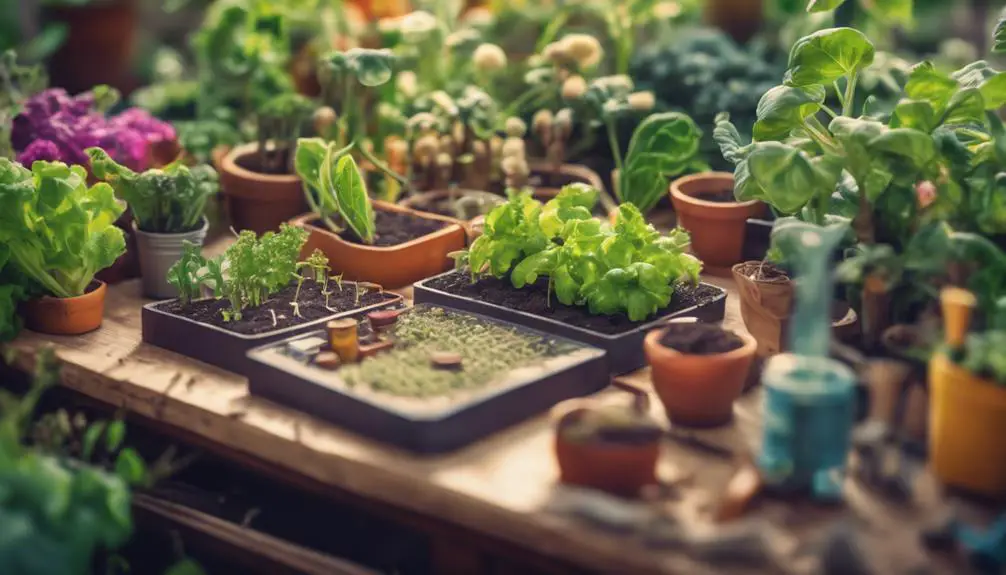
When selecting vegetable seeds, consider factors such as climate, soil type, and desired harvest period to guarantee you’re choosing varieties that will thrive in your specific growing conditions.
Climate considerations are vital, as some vegetables are more tolerant of heat, cold, or moisture than others. For instance, if you live in an area with hot summers, look for heat-tolerant varieties of tomatoes and peppers. Conversely, if you experience cool springs, choose broccoli and kale varieties that mature quickly.
In terms of seed selection, look for disease-resistant and pest-tolerant varieties to minimize potential issues. Additionally, consider the days to maturity, which indicates how long it takes for the vegetable to reach harvest.
If you have a short growing season, opt for varieties with shorter days to maturity. You can also choose seeds that are specifically bred for your region’s climate.
Preparing Your Garden Soil
Before sowing your carefully selected seeds, you must prepare your garden soil to provide a fertile foundation for your vegetables to grow.
This vital step guarantees your plants receive the necessary nutrients, water, and air to thrive.
Start by evaluating your soil structure, which can be clay, silt, or sand-based.
Ideally, you want a mix of all three, known as loam, which drains well and retains moisture.
If your soil is heavy clay or sandy, amend it with organic matter like compost or well-rotted manure to improve its structure.
Next, test your soil pH, which should fall between 6.0 and 7.0 for most vegetables.
If your soil is too acidic or alkaline, adjust it by adding lime or sulfur accordingly.
Finally, remove any debris, rocks, and weeds that can compete with your vegetables for resources.
Easy Leafy Greens to Grow
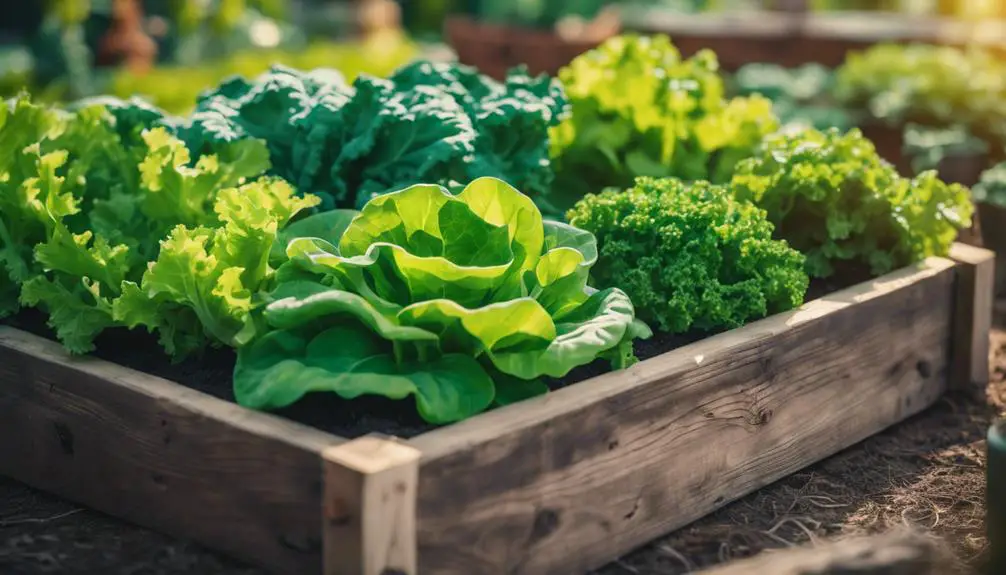
With your soil prepared, you can now focus on planting easy-to-grow leafy greens, which require minimal care and can thrive in a variety of conditions.
These Leafy Delights are perfect for beginners, as they’re quick to mature and can be harvested in as little as 20 days.
Start with popular varieties like lettuce, kale, and spinach, which are Green Machines when it comes to producing a bountiful crop.
Sow seeds thinly and evenly, about 2-4 inches apart, and water gently. Leafy greens prefer cooler temperatures and consistent moisture, so certify your soil is well-draining and receives partial shade.
As your greens grow, keep the area weed-free and fertilize lightly.
Harvest leaves when they’re young and tender, and enjoy the fruits of your labor in salads, smoothies, or as a nutritious snack.
With proper care, you’ll be enjoying a continuous supply of fresh, delicious leafy greens all season long.
Radish and Carrot Growing Tips
As you begin growing radishes and carrots, you’ll want to focus on preparing the soil to guarantee perfect growth.
You’ll need to loosen the soil to a depth of 8-10 inches to allow for proper root development, and mix in organic matter to improve its structure.
Soil Preparation Tips
You’ll want to loosen the top 12 to 18 inches of soil to a fine, crumbly texture, removing any debris, rocks, or weeds that could impede radish and carrot growth.
This will guarantee the roots can grow freely and evenly.
Before you start, conducting soil testing is crucial to determine the pH level and nutrient content of your soil.
This will help you identify any deficiencies and make necessary amendments.
Create a garden mapping plan to visualize your soil’s layout and identify areas that may require extra attention.
When preparing the soil, add organic matter like compost or well-rotted manure to improve its structure and fertility.
Mix it well into the soil, taking care not to compact it.
If your soil is heavy clay or sandy, amend it with organic matter and perlite or vermiculite to achieve a well-balanced mix.
Finally, rake the soil to create a smooth, even surface.
With your soil properly prepared, you’ll be ready to sow your radish and carrot seeds, giving them the best chance to thrive.
Pest Control Methods
After preparing the soil, it’s time to focus on protecting your radish and carrot crops from unwanted visitors that can decimate your harvest, including pests like root maggots, slugs, and snails.
These pesky creatures can cause significant damage, but don’t worry, you’ve got a range of natural deterrents and organic pesticides at your disposal.
For radishes, try companion planting with nasturtiums, which repel aphids and whiteflies.
Carrots, on the other hand, benefit from being planted alongside sage, which deters carrot flies.
You can also use physical barriers, like fine-mesh row covers, to prevent pests from reaching your crops.
For more severe infestations, consider using organic pesticides like neem oil or pyrethrin.
These natural solutions are gentler on the environment and won’t harm beneficial insects.
By incorporating these methods into your pest control strategy, you’ll be well on your way to a healthy, thriving harvest.
Tomatoes for Small Spaces
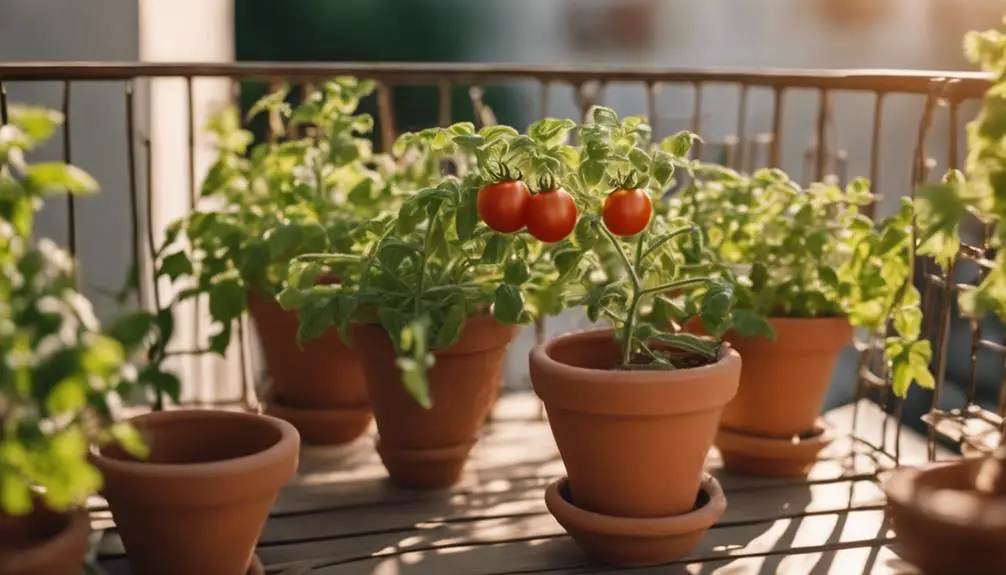
When growing tomatoes in small spaces, you’ll want to focus on varieties that won’t overrun your containers or plots.
You’ll need to choose space-saving varieties that are bred for compact growth, such as patio or dwarf tomatoes, which will thrive in tight spaces.
Space-Saving Varieties
Growing compact tomato varieties allows you to harvest a bounty of fruit in even the smallest of spaces, making them ideal for urban gardeners and those with limited growing areas.
By choosing varieties that are bred for their compact growth habit, you can maximize your yield while minimizing the space required.
For instance, ‘Patio’ and ‘Tiny Tim‘ are two popular compact varieties that thrive in small spaces.
These varieties are perfect for vertical gardening, where you can train the plants to grow up a trellis or cage, making the most of your available space.
Compact planting is another technique you can use to grow multiple plants in a small area.
By spacing plants closely together, you can increase your overall yield while reducing the space required.
With compact tomato varieties and clever planting techniques, you can enjoy a bountiful harvest even in the smallest of spaces.
Container Growing Tips
To successfully grow tomatoes in containers, you’ll need to provide your plants with a well-draining potting mix and a pot that’s at least 5-gallons in size to accommodate the root system.
This will guarantee your plants receive adequate oxygen and water, reducing the risk of root rot.
When selecting a container, consider one with built-in drainage systems, such as holes or a built-in water reservoir, to prevent waterlogging.
Avoid using small containers, as they can limit root growth and reduce yields.
Instead, opt for larger containers that provide ample space for the roots to spread out.
For example, a 10-15 gallon container would be ideal for indeterminate tomato varieties.
Additionally, make sure your container has good aeration, as this will promote healthy root growth and prevent fungal diseases.
Cucumbers and Squash Made Easy
Cucumbers and squash are two of the most beginner-friendly vegetables to cultivate, requiring minimal equipment and maintenance while still yielding a bountiful harvest.
These warm-season crops thrive in temperate climates and can be trained to grow vertically, making them perfect for small gardens or urban spaces.
For a summer harvest, plant cucumber and squash seeds in well-draining soil with full sun exposure. To maximize space, consider using a vertical trellis to support their vining habits. Simply weave the stems through the trellis’s openings as they grow, and you’ll be rewarded with a lush, productive display.
Keep the soil consistently moist, but avoid overwatering, which can lead to fungal diseases. With regular watering and fertilization, you can expect a steady supply of fresh cucumbers and squash throughout the summer months.
Green Beans for Beginners
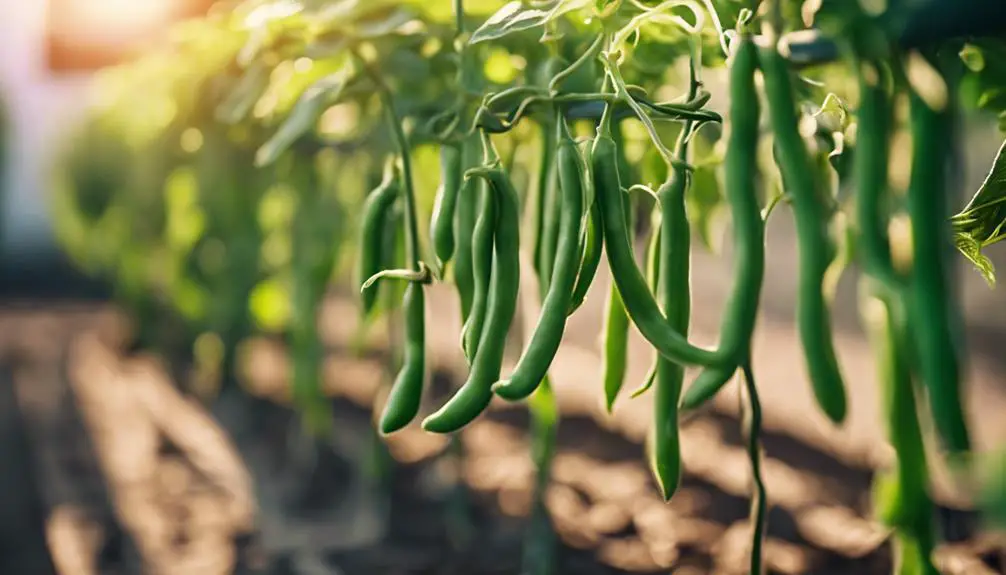
Precision and planning are key when it comes to cultivating green beans, a cool-season crop that thrives in well-draining soil and partial shade.
You’ll want to choose a location that receives at least 6 hours of direct sunlight a day, but also provides some protection from intense heat.
When selecting green bean varieties, consider whether you prefer bush or pole beans. Bush beans are compact and require minimal support, while pole beans will need a trellis or other structure to climb. You can also opt for a combination of both, such as a semi-bush variety.
Regardless of the type, make sure to plant your green beans about 1-2 inches deep and 2-3 inches apart after the last frost. Provide consistent moisture, but avoid overwatering, which can lead to disease.
As your beans grow, you’ll need to train them to climb up the trellis or provide support for the bush varieties.
With proper care, you can expect to harvest your green beans in about 50-60 days.
Herbs to Grow With Vegetables
Growing herbs alongside your vegetables can enhance their flavors and aromas, and many herbs, such as basil and cilantro, have natural pest-repelling properties that can benefit nearby plants.
By incorporating herbs into your vegetable garden, you can create a more diverse and resilient ecosystem. Companion planting, also known as intercropping, is the practice of growing different plants together to improve their growth, health, and productivity.
When it comes to herb pairings, some popular combinations include basil with tomatoes, mint with cucumbers, and dill with carrots. These pairings not only enhance flavors but also deter pests and diseases.
For example, basil repels aphids and whiteflies, which can be detrimental to tomatoes. By strategically placing herbs among your vegetables, you can reduce the need for pesticides and create a more balanced and sustainable garden.
Experiment with different herb pairings to find the perfect combinations for your vegetable garden.
Zucchini and Yellow Squash

As a beginner, planting zucchini and yellow squash in your garden can be a rewarding experience, as these warm-season crops are easy to grow and can thrive in a variety of conditions.
You’ll want to plant them in well-draining soil with full sun, about 1 inch deep and 2-3 feet apart. Water them regularly, but avoid overwatering, which can lead to fungal diseases.
You can expect a summer harvest in about 35-45 days.
Zucchini and yellow squash are versatile vegetables that can be harvested at various stages of maturity, offering different flavor profiles.
Pick them when they’re small and tender for a sweet, nutty flavor, or let them mature for a more robust taste.
You can grill, sauté, or bake them, and they pair well with a variety of herbs and spices.
With proper care, you can enjoy a bountiful harvest of these delicious and nutritious vegetables all summer long.
Peppers for Every Palate
You can choose from a diverse range of pepper varieties to suit your taste preferences, from sweet and mild to hot and spicy.
Sweet peppers are an excellent choice for beginners, offering a crunchy texture and a subtle sweetness that pairs well with a variety of dishes. They’re also incredibly easy to grow, requiring minimal care and maintenance.
If you prefer mild flavors, look for varieties like ‘Bell Boy’ or ‘California Wonder’, which offer a sweet, slightly smoky taste without any heat. For a bit more zing, try ‘Pimento’ or ‘Cubanelle’, which add a touch of spice to your meals without overwhelming your taste buds.
Regardless of the variety, peppers thrive in well-draining soil and full sun, making them an ideal addition to your beginner garden. With proper care, you can expect a bountiful harvest of delicious, flavorful peppers to enjoy all season long.
Simple Irrigation Techniques
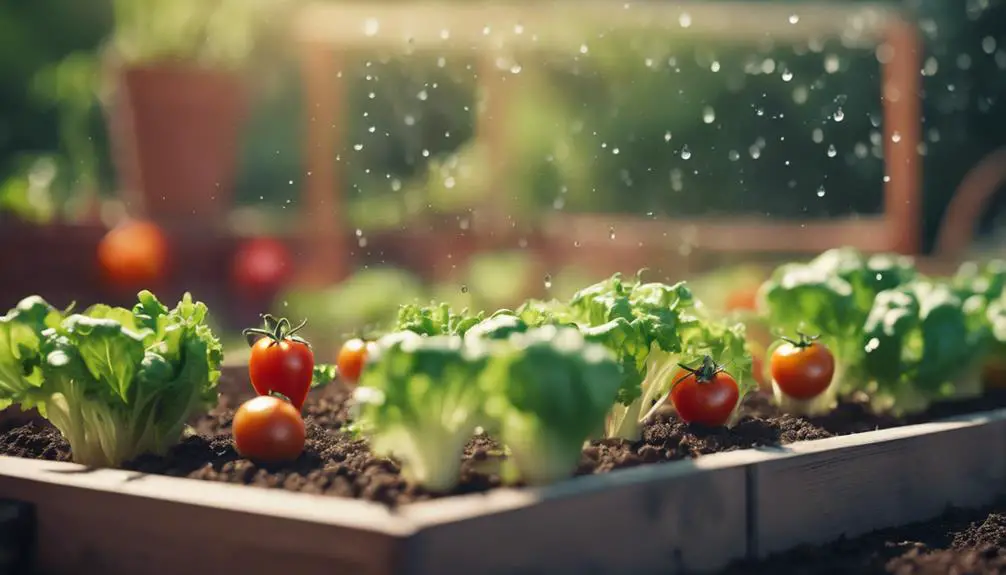
Two essential components of a simple irrigation system are soaker hoses and drip irrigation lines, which deliver water directly to the roots of your vegetables, reducing evaporation and runoff.
These efficient systems guarantee your vegetables receive the right amount of water, exactly when they need it.
You can further optimize your irrigation system by incorporating water timers, which allow you to schedule watering sessions in advance.
This feature is particularly useful for busy gardeners who can’t always be on-site to water their vegetables.
Drip systems, in particular, are an excellent choice for beginners.
They consist of a network of tubes with emitters that release water directly into the soil, reducing waste and promoting healthy plant growth.
By using a drip system, you can target the root zone of each plant, delivering water precisely where it’s needed.
Additionally, drip systems are easy to install and can be customized to fit the unique needs of your garden.
With a well-designed irrigation system, you’ll be able to enjoy a bountiful harvest with minimal effort.
Common Pests to Watch Out
Several common pests can wreak havoc on your vegetable garden, and being aware of their presence is crucial to taking prompt action and preventing infestations.
As a vigilant garden inspector, you should regularly scan your plants for signs of pest activity, such as holes in leaves, yellowing, or dropped fruit.
Some pests, like aphids and whiteflies, are attracted to sweet or sticky substances, making them pest attractors. Others, like slugs and snails, are drawn to moisture and hiding places.
To outsmart these pests, you can employ various control methods.
For instance, you can introduce natural predators, like ladybugs or lacewings, to prey on aphids and other soft-bodied pests.
You can also use physical barriers, such as fine-mesh screens, to exclude pests from your plants.
Additionally, you can apply organic pesticides, like neem oil or pyrethrin, to target specific pests.
Harvesting Your Fresh Vegetables
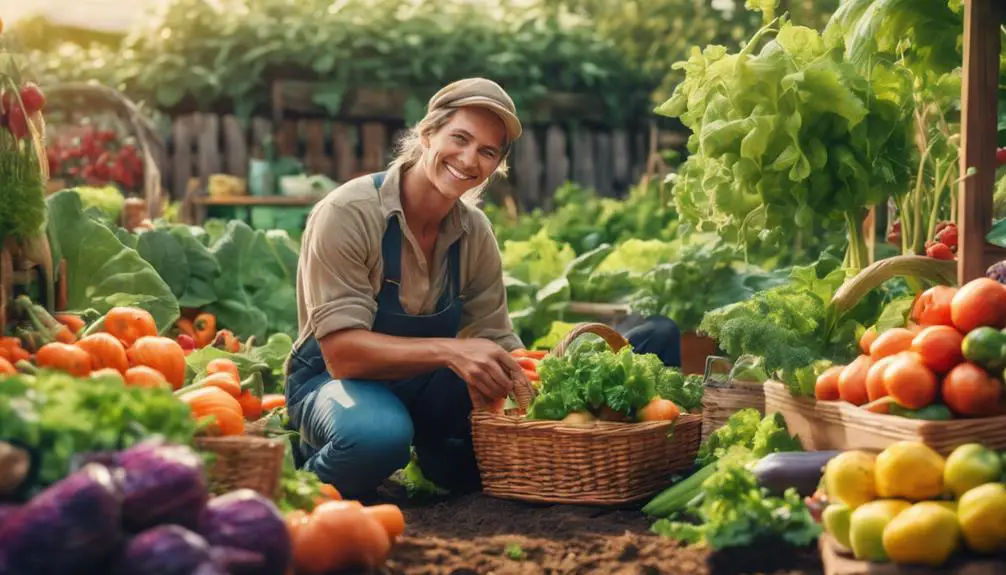
Every morning, inspect your vegetable plants for ready-to-pick produce, as timely harvesting guarantees peak flavor, texture, and nutritional value.
You’ll be surprised at how quickly your hard work pays off. Regular fresh picking encourages continuous production, so you’ll enjoy a bountiful harvest throughout the growing season.
When checking for ripe vegetables, look for visual cues like color, shape, and size.
For leafy greens, simply snip off the largest leaves, leaving the plant intact to promote further growth.
For vining plants like cucumbers and zucchini, check for size and gently twist to release from the stem.
Tomatoes will be fully ripe when they’re fully red and slightly soft to the touch.
Frequently Asked Questions
Can I Grow Vegetables in Containers on My Apartment Balcony?
“You can thrive in container gardening on your apartment balcony by understanding balcony microclimates and selecting the right container materials, such as self-watering planters or those with built-in aeration systems, to optimize growth.”
How Often Should I Water My Vegetables During Hot Summer Days?
During hot summer days, you’ll need to water your vegetables more frequently, checking soil moisture daily. Aim to provide about 1-2 inches of water per week, either through rainfall or summer watering, ensuring the top 6-8 inches of soil remain consistently moist.
Will Deer Eat My Vegetables if I Plant Them in My Backyard?
You’ll need to protect your backyard vegetable garden from deer damage by considering deer repellents like predator urine or hot pepper sprays, and fencing options like 8-foot tall wire mesh or electric fencing to keep them out.
Can I Use Fertilizer From My Local Gardening Store on My Vegetables?
You can use fertilizer from your local gardening store on your vegetables, but consider opting for organic alternatives like compost or manure tea, which provide slow-release nutrients, promoting healthy soil microbiomes and reducing environmental impact.
How Do I Store My Harvested Vegetables to Keep Them Fresh Longer?
When harvesting, you’ll want to store your veggies properly to maintain freshness. Use a veggie crisper or root cellar to keep them cool, dry, and away from direct sunlight, ensuring ideal flavor and texture preservation.
Conclusion
Starting a vegetable garden can be a breeze, even for beginners.
By selecting easy-to-grow varieties like leafy greens, radishes, and carrots, and following simple growing tips, you’ll be enjoying fresh produce in no time.
Remember to prepare your soil, irrigate wisely, and keep an eye out for pests.
Now, get harvesting and reap the rewards of your labor!



